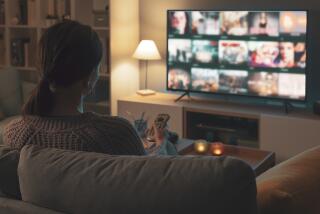Study Finds TV Tops Kids’ Big Diet of Media
- Share via
NEW YORK — American children spend the equivalent of an adult workweek--or more than 38 non-school hours per week--consuming media and often do it with little parental monitoring, according to a study released Wednesday by the Kaiser Family Foundation.
The study, which defined media broadly as everything from television to computer games, recreational reading and listening to music, also found that despite the increasing presence of computers in the home, children still spend the largest chunk of media time watching television. Surprisingly, very little time was spent on the Internet, with kids using computers about 21 minutes a day for non-school activities. Kids also said they read an average of 44 minutes per day.
Kaiser officials said their study, called “Kids & Media@The New Millennium,” was a first of its kind and that they were startled by many of its findings, including the sheer volume of time, an average five hours and 29 minutes per day, that kids spend with some form of media and the fact that so much media time was unsupervised.
Others immediately seized upon the study. At a panel discussion in New York after presentation of the data, New York University professor Neil Postman called the amount of time kids spend with media a cause for concern. “Television, especially, seems to be the command center of the culture.”
Federal Communications Commission Chairman William Kennard said the study proves “we’ve got to find new ways to protect our children in this environment,” such as with the little-used V-chip that lets parents lock out objectionable TV material.
Rapper Chuck D argued that children need to be taught by parents how to navigate media. “You have to teach them how to swim and duck the sharks,” he said.
Elizabeth Thoman, founder and president of the Los Angeles-based Center for Media Literacy, which promotes teaching children how to be critical media consumers, said in an interview that she welcomed the study for its comprehensiveness. “It’s a great piece of data that we’ve been missing.”
Among the study’s findings are that two-thirds of children 8 and older have a TV set in their bedroom, as do one-third of children ages 2 to 7. One in 10 children has bedroom Internet access. Kids’ bedrooms “are becoming media central,” said Vicky Rideout, director of Kaiser’s Program on the Entertainment Media and Public Health.
Among the group 8 and older, two-thirds said the TV is usually on during meals at home and almost that many said their parents have no rules about TV watching.
Betsy Frank, executive vice president of research for MTV Networks, said the MTV cable outlets have been tracking similar data and making it public since 1997, and that “overall, there were no big surprises. We know how much time kids spend with the media choices they have.”
Moreover, she said, “you can’t understand the kid just by understanding his or her media usage. . . . Kids are exposed to a lot of media; nobody is going to deny that. That said, kids are exposed to a lot of other things in their lives, and everything we’ve seen says that the kids are growing up just fine.”
The Kaiser study examined media use among a sample of 3,155 children ages 2 to 18, with parents answering questions about younger children’s habits. The foundation, based in Menlo Park, Calif., “has an interest in pro-actively working with the entertainment media,” Rideout said, but first “we need to know where children are spending their time and attention.”
Although Kaiser officials largely refrained from drawing conclusions from the study, one of its authors, Stanford University professor Donald F. Roberts Jr., said the lack of supervised media time, particularly unsupervised TV viewing, “is cause for concern.” He said children learn how to view media by watching with their parents.
But parental supervision is the one area where Frank said MTV’s data, which largely mirror Kaiser’s findings, differ sharply from the new study. MTV has similar data about the number of kids with in-room TVs and computers, she said, but far more children in the MTV surveys said they watched TV or did computer work with parental oversight. For example, the Kaiser study found that kids 8 and older said just 5% of their TV viewing was done with a parent; MTV’s research found that 70% of viewing among kids 4 to 11 was done with a parent, dropping to 53% among teens ages 12 to 18.
Kaiser’s research found that children ages 8 and older spend an average of six hours and 43 minutes a day consuming media, compared with three hours and 30 minutes for children younger than 8. There was a clear divide among white and nonwhite children, with nonwhites spending nearly an hour more per day on average with media.
White children were also far more likely to have computers at home (78%) than were black (55%) or Latino (48%) children. And children in upper-income areas were more likely to have home computers. But even though there was a gap in home computers between high- and low-income areas, computer usage largely leveled out when school computer use was factored in, the study found.
The average child’s day includes two hours and 46 minutes of TV viewing to just 34 minutes of computer time, which drops to 21 minutes when only non-school-related computer work is counted. Fewer than 1 in 10 kids spent more than an hour per day using a computer for fun.
Thoman said the amount of time kids spend with media shouldn’t be surprising. “I think we’re going to find more and more of their time is spent swimming in the media. It’s all the more reason that we’ve got to give kids the skills to navigate their culture in a healthy way.”
She said she was particularly interested in the amount of time kids said they listened to CDs, tapes or the radio (one hour and 27 minutes), which was second only to TV. “We tend to get obsessed with television or computers.”
Thoman also cautioned against drawing conclusions about the effect that the amount of media usage has on children.
“Media is not like a disease you can inoculate against. That’s an obsession of the United States: Instead of looking at the issue qualitatively, we get caught up in whether it has a good or bad effect. That’s simplistic. We have to learn to see how media is shades of gray . . . and look at how education is the solution.”
(BEGIN TEXT OF INFOBOX / INFOGRAPHIC)
Media Use by Children
A Kaiser Family Foundation study found that American children spend an average of 5 hours and 29 minutes per day with various media:
*
Source: Kids & Media at the New Millenium, Kaiser Family Foundation, November 1999
More to Read
The complete guide to home viewing
Get Screen Gab for everything about the TV shows and streaming movies everyone’s talking about.
You may occasionally receive promotional content from the Los Angeles Times.






